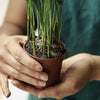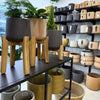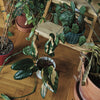What does a healthy maid (not) look like and how to recognize one?

It's probably happened to everyone. You bought a new maid, and in a few weeks she died despite your honest care. But you have to realize whether the maid was attacked and you didn't notice it, or she was healthy but you didn't give her the care she needed and she didn't survive. Acclimatization of the plant in a new environment is very important, especially at the time when you are acquiring the plant. There are plants that handle moving very well, but there are also those that are very susceptible to any kind of movement. Let's go through what to look out for when buying plants, what a healthy plant looks like, and what at first glance might indicate something bad, but it's okay.
A few tips when buying plants
1. When shopping online , trust but verify. Is this your first time buying from an online retailer? Order a small bite first to try before buying more plants. Avoid possible disappointment in the event that the seller does not pay too much for the quality transport of plants.
2. When the order of plants arrives , after unpacking the plant, immediately inspect it in detail for mechanical damage, wilting or pests. Complaints made several days and weeks later are often no longer acceptable and it is difficult to prove whose fault it is.
3. Do you shop in chain stores and brick-and-mortar stores? Great, you get a chance to see exactly what you're buying. Examine the plant closely, focusing on the leaves and coloration. If it looks shriveled or even contains bugs visibly marching on the leaves, it is better to avoid the plant. These are often non-specialized stores and care for maids is weak and the substrate is only transportable.
How do we do it in Give Me a Maid (DMP)?
Our main priority has been and will be selling maids in perfect condition. When purchasing from our suppliers, we only select plants for the e-shop and our store after a thorough inspection . In addition, we transplant the houseplants the same day into a high-quality substrate that we prepare ourselves, thereby ensuring better conditions for the plant's growth and transport. The plants are placed in our warehouse, where the best conditions are for the vast majority of plants, i.e. warmth, good lighting, high humidity and our loving care. 💚
How to recognize a healthy maid
The basis for the good growth of our green darlings is above all their good condition, which goes hand in hand with suitable growing conditions. The overall appearance of the plants is therefore essential when choosing a houseplant at the store.

Photo: Visibly dry and blackened leaves indicate poor care, probably insufficient watering and moisture.
Leaves
Focus on the leaves. The plant should have healthy vital leaves. It should not contain a large amount of dry or rotten leaves. Too many brown or yellow spots also do not indicate the best care to date. After all, we don't buy artificial fakes :) But these are plants and occasional stains, some yellowing or mechanical damage here and there is normal.
At DMP, we thoroughly check the plants that we offer for sale, and we do not accept unsightly or mechanically damaged plants.

Photo: Worms (pests) on the underside of a plant leaf
Pests
The biggest hell that you often only discover at home and often long after you already have it on the shelf. If you buy a plant in a store, really look at the plant. Look at the stems, the undersides of the leaves, and the top of the substrate. If the plant contains cobwebs, or clusters of eggs or small bugs, it may be a plant attacked by pests. More about pests here. It often happens that pests are present in the substrate itself and nothing can be seen at a glance, in which case we will unfortunately have to deal with it at home with a suitable treatment. Pests that can be seen with the naked eye are usually in the stage where they are just multiplying and start to be seen when there are many of them on the plant. They also often get to the plant in the substrate itself, when it is impossible to see them with the naked eye, this happens to anyone.
If it sometimes happens that a pest attacks our plant, we move the plant to quarantine and treat it for the appropriate period of time. If it is completely fine and has not suffered any losses, we return it for sale. In most cases, however, we detect pests already when we collect from our suppliers and send the plants back.
Plant composition
An elongated plant with few leaves usually indicates insufficient light conditions. A healthy looking plant usually has better branching. Some types of rooms that are supposed to look like this can be confusing.
Deficiencies on plants that (don't) bother

Photo: Xanthosoma with a beautiful neon color and a withered leaf tip that is only visible up close
Dry leaf tips
Many plants have dried plant tips. This is a normal condition for most plants, which is usually caused by insufficient moisture. Usually it doesn't bother anything and it's not even visible. The problem would be, of course, if the entire leaf started to dry from the tip and the leaves would start to turn yellow, which would indicate a bigger problem either with care, with pests, or with overwatering the plant.

Photo: Healthy Philodendron Scandens with minor mechanical damage to the leaf.
Mechanical damage
Sometimes it happens that a sheet has a groove, a small hole or is slightly torn. Even such a minor mechanical defect is not life-threatening and will not harm the plant in any way. Sometimes it even happens that the plant already grows like this and no one caused it, even if it was unintentional.
Mold on the top of the substrate
Mold on the upper substrate very often forms when the air humidity is higher and the substrate is a little more wet. This is nothing unusual, the mold will soon disappear and will not harm the plant. Just fluff the top part of the substrate slightly and let the substrate dry a little before watering the plant again.
Small spots on the leaves
If the plant has a small spot of brown color here and there or is dry, it is nothing serious. On the contrary, when choosing a plant, we should pay attention to black spots and maps, which in many plants indicate a significant overflow as well as extreme yellowing of the leaves. In this case, the roots begin to rot and the plant dies. In this case, do not take the plant from the store, it could die. If this happens to you at home, we recommend removing the plant from the pot, inspecting the roots, transplanting it into a new substrate and letting it dry for 1-2 days. Black spots are most visible when overwatering, for example, with ficus elastica and zamiokulkas . With other plants, e.g. Monstera Monkey Mask or Ficus Benjamina , it is more about the yellowing of the leaves and subsequent falling off.

Photo:Sophora Little Baby attacked by mealybugs, which are almost invisible until they multiply significantly. Sophora sometimes falls off even when it is completely healthy due to a change in environment
Falling leaves a few days after purchasing the plant
Sometimes it happens that you get or buy a beautiful green plant, it makes you happy at home for a few days, and then the plant starts to fall off. At this moment, keep calm and don't panic, especially don't water the plant right away. First, find out why this is happening. A lot of plants are so-called "drama queens" and it is common for them to drop their leaves when the environment changes. Ficus Benjamina or Sophora Little Baby are among the largest succulents, we have already written an article about its care. In the worst case, you chose the wrong location at home and the plant does not want to get used to the new conditions. Try to move the plant to a more correct place.
Wilted plant
Have you ever bought a plant that looks nice, but then it seems to wilt even though it doesn't lose color and you have watered it? This will probably make things easier for you, maybe you bought a so-called prayer book . These are houseplants, for which it is quite normal that they either react to light and as soon as it gets dark, the plant lays down and may look as if it has withered, or they react to watering by starting to grow branches and leaves, all you have to do is water them and within a few dozen minutes he stands up again. Among the most famous praying mantises are, for example, Oxalis Triangularis , Calathea and Marantha .
Flying flies
Sometimes it happens that flies fly out of a new plant and slowly infest the whole apartment. Don't worry, flies are usually harmless as long as you don't let them breed excessively. These are the so-called mourning beetles and their larvae are usually already present in the substrate itself, so it is not easy to detect them in advance. For these little monsters, you just need to buy yellow glue boards , which you stick into the substrate near the plant and it will gradually catch all the hatched flies.
What should definitely be avoided?
If you buy a room plant in a store and you are on the road all day, especially in the winter months or at temperatures around 10 ° C, you should make sure that the plant is well insulated from the cold air and well wrapped. Walking around the city with a plastic bag and an exposed plant is not desirable, and it is very likely that the plant will let you know about this very soon by wilting or dropping leaves. Why? She simply caught a cold. Most roommates come from the tropics and require temperatures of around 20°C and above, and the transition from heat to winter or being outside for a few tens of minutes, whether in a bag or not, does not do them any good.
In the same way, in the summer, when temperatures are around 30° C in the shade, it is not advisable to buy plants, leave them in the car, where temperatures can rise to 60° C. In such a case, you boil the plant for a change or it has time to completely dry out and under pressure the heat will wither before you can get it home. Be careful even when walking around the city with the plant in direct sunlight for a long time, many plants cannot tolerate direct sunlight.
If she brings her new addition home, never put the plant in direct sunlight, even if it's a plant that doesn't mind it. Consider that the plant spent long weeks with growers in greenhouses, then went through several transports before reaching us and is not used to direct sun, but to fluorescent grow lights. It is necessary to let the plant adapt to your home environment preferably in partial shade for a few days if not weeks and only then move it to a permanent location.
Good luck and if you don't like your plant, be sure to write to us :)
Author: Martin Seidl
-
Posted in
Zajímavosti a tipy




